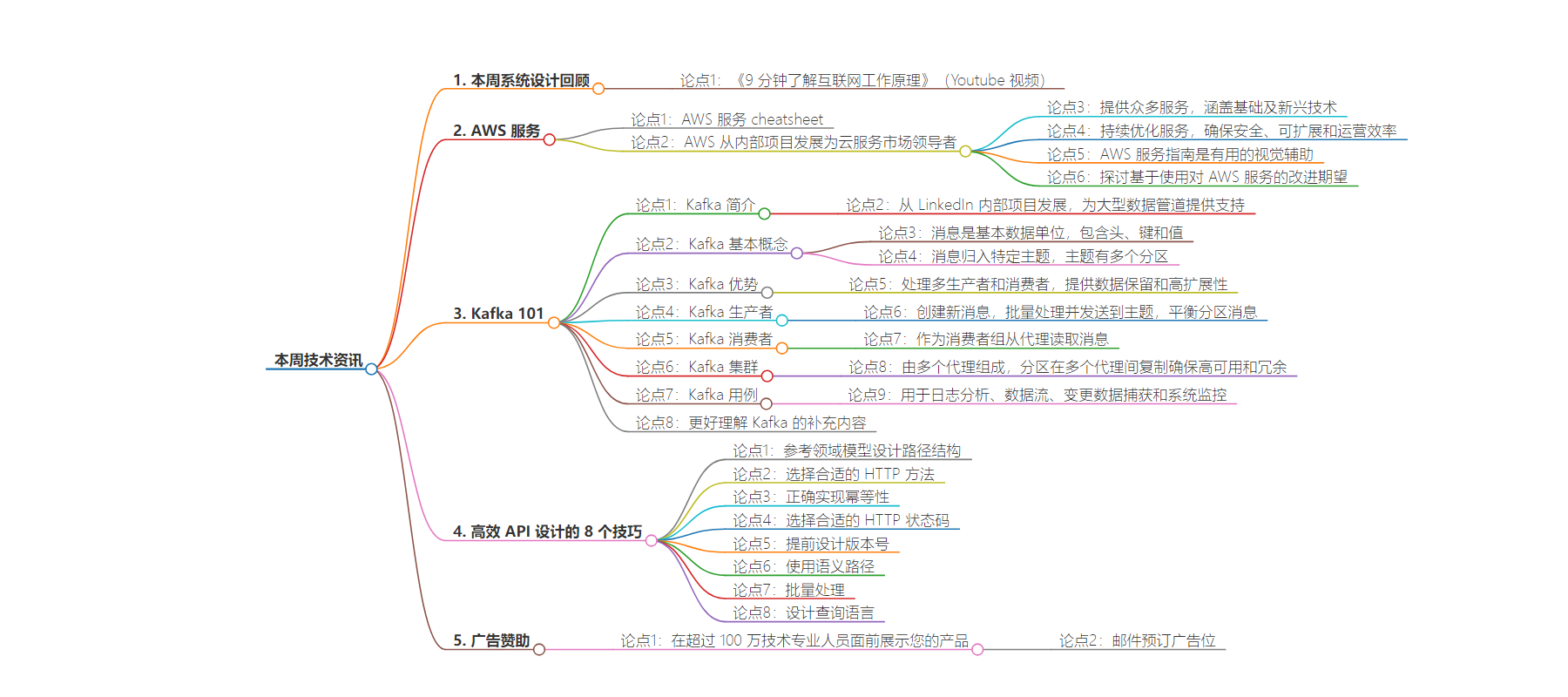包阅导读总结
1.
“`
Kafka、AWS 服务、API 设计、QA Wolf、系统设计
“`
2.
本周的内容涵盖了系统设计复习、Kafka 基础、高效 API 设计技巧、AWS 服务介绍、QA Wolf 对测试的帮助等。包括 Kafka 的基本概念、优势和使用场景,以及 API 设计的要点和 AWS 服务的相关信息。
3.
– 系统设计
– 本周系统设计复习:9 分钟了解互联网工作原理的视频
– Kafka
– 介绍了 Kafka 的基本概念,如消息、主题和分区
– 列举了 Kafka 的优势,包括处理多生产者和消费者等
– 提到了 Kafka 的生产者、消费者和集群
– 给出了 Kafka 的使用案例
– API 设计
– 参考域模型设计路径结构
– 选择合适的 HTTP 方法
– 正确实现幂等性
– 选择恰当的 HTTP 状态码
– 提前设计版本
– 使用语义路径
– 进行批量处理
– 设计查询语言
– AWS 服务
– 从内部项目发展为云服务市场领导者
– 提供众多服务,用户可借助服务指南探索
– 询问用户对服务改进的期望
– QA Wolf
– 能帮助组织快速完成测试套件,提高反馈速度和开发信心
– 使 Drata 团队获得显著成果
– 评级高,可预约演示了解更多
– 广告
– 可向超 100 万科技专业人士展示产品
– 广告位通常提前 4 周售罄,可通过邮件预定
“`
思维导图:
文章地址:https://blog.bytebytego.com/p/ep126-the-ultimate-kafka-101-you
文章来源:blog.bytebytego.com
作者:ByteByteGo
发布时间:2024/8/24 15:30
语言:英文
总字数:831字
预计阅读时间:4分钟
评分:87分
标签:Kafka,分布式系统,流平台,数据管道,生产者和消费者
以下为原文内容
本内容来源于用户推荐转载,旨在分享知识与观点,如有侵权请联系删除 联系邮箱 media@ilingban.com
This week’s system design refresher:
-
How the Internet Works in 9 Minutes (Youtube video)
-
AWS Services Cheat Sheet
-
The Ultimate Kafka 101 You Cannot Miss
-
8 Tips for Efficient API Design
-
SPONSOR US
Are slow test cycles bottlenecking your dev teams’ release velocity? With QA Wolf, your organization can run entire test suites in minutes for faster feedback and developer confidence to ship.
QA Wolf takes testing off your plate. They can get you:
The benefit? No more manual E2E testing. No more slow QA cycles. No more bugs reaching production.
With QA Wolf, Drata’s team of 80+ engineers achieved 4x more test cases and 86% faster QA cycles.
🌟Rated 4.8/5 on G2.
Schedule a demo to learn more
AWS grew from an in-house project to the market leader in cloud services, offering so many different services that even experts can find it a lot to take in.
The platform not only caters to foundational cloud needs but also stays at the forefront of emerging technologies such as machine learning and IoT, establishing itself as a bedrock for cutting-edge innovation. AWS continuously refines its array of services, ensuring advanced capabilities for security, scalability, and operational efficiency are available.
For those navigating the complex array of options, this AWS Services Guide is a helpful visual aid.
It simplifies the exploration of AWS’s expansive landscape, making it accessible for users to identify and leverage the right tools for their cloud-based endeavors.
Over to you: What improvements would you like to see in AWS services based on your usage?
If you’re not a paid subscriber, here’s what you missed.
-
A Crash Course on Scaling the API Layer
-
A Crash Course on Architectural Scalability
-
A Crash Course on Microservices Design Patterns
-
A Crash Course on Domain-Driven Design
-
“Tidying” Code
To receive all the full articles and support ByteByteGo, consider subscribing:
Kafka is super-popular but can be overwhelming in the beginning.
Here are 8 simple steps that can help you understand the fundamentals of Kafka.
-
What is Kafka?
Kafka is a distributed event store and a streaming platform. It began as an internal project at LinkedIn and now powers some of the largest data pipelines in the world in orgs like Netflix, Uber, etc. -
Kafka Messages
Message is the basic unit of data in Kafka. It’s like a record in a table consisting of headers, key, and value. -
Kafka Topics and Partitions
Every message goes to a particular Topic. Think of the topic as a folder on your computer. Topics also have multiple partitions. -
Advantages of Kafka
Kafka can handle multiple producers and consumers, while providing disk-based data retention and high scalability. -
Kafka Producer
Producers in Kafka create new messages, batch them, and send them to a Kafka topic. They also take care of balancing messages across different partitions. -
Kafka Consumer
Kafka consumers work together as a consumer group to read messages from the broker. -
Kafka Cluster
A Kafka cluster consists of several brokers where each partition is replicated across multiple brokers to ensure high availability and redundancy. -
Use Cases of Kafka
Kafka can be used for log analysis, data streaming, change data capture, and system monitoring.
Over to you: What else would you add to get a better understanding of Kafka?
-
Domain Model Driven
When designing the path structure of a RESTful API, we can refer to the domain model. -
Choose Proper HTTP Methods
Defining a few basic HTTP Methods can simplify the API design. For example, PATCH can often be a problem for teams. -
Implement Idempotence Properly
Designing for idempotence in advance can improve the robustness of an API. GET method is idempotent, but POST needs to be designed properly to be idempotent. -
Choose Proper HTTP Status Codes
Define a limited number of HTTP status codes to use to simplify application development. -
Versioning
Designing the version number for the API in advance can simplify upgrade work. -
Semantic Paths
Using semantic paths makes APIs easier to understand, so that users can find the correct APIs in the documentation. -
Batch Processing
Use batch/bulk as a keyword and place it at the end of the path. -
Query Language
Designing a set of query rules makes the API more flexible. For example, pagination, sorting, filtering etc.
Get your product in front of more than 1,000,000 tech professionals.
Our newsletter puts your products and services directly in front of an audience that matters – hundreds of thousands of engineering leaders and senior engineers – who have influence over significant tech decisions and big purchases.
Space Fills Up Fast – Reserve Today
Ad spots typically sell out about 4 weeks in advance. To ensure your ad reaches this influential audience, reserve your space now by emailing sponsorship@bytebytego.com
